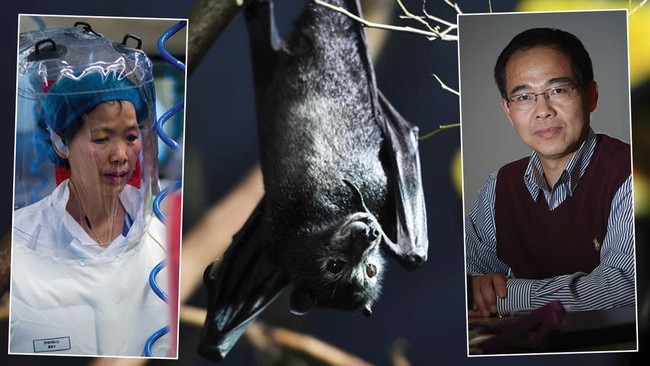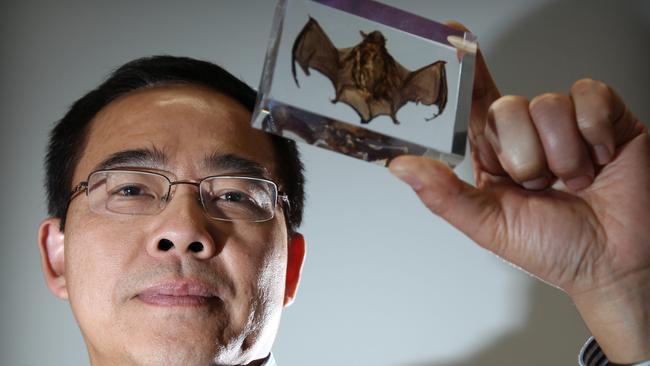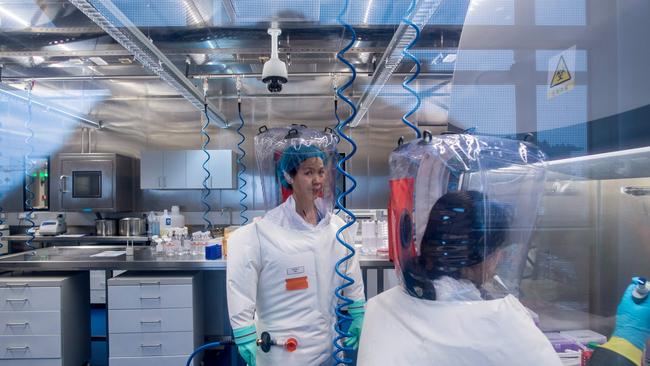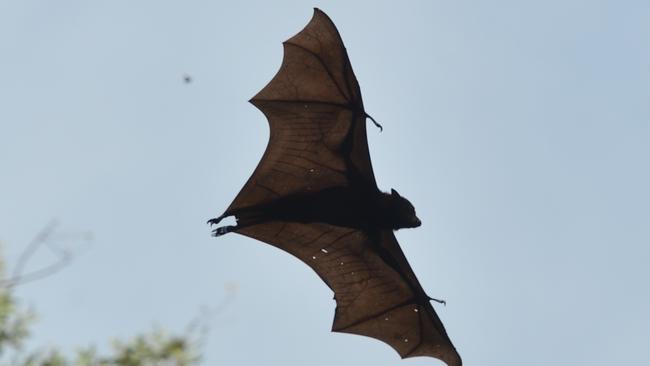Bat scientists warn that the world may never know Covid-19 origins
Researchers believe bats harbour deadly viruses that cause SARS, Ebola and other diseases, but proving it can be frustratingly inconclusive.

Since the start of the Covid-19 pandemic, scientists all over the world have been struggling to pin down the origin of the coronavirus that caused it.
Linfa Wang knows they may never succeed.
Dr. Wang, a professor in the emerging infectious diseases program at Duke-NUS Medical School in Singapore, is an expert in bat viruses. He has joined the hunt for the origin of Covid-19 even though he and fellow scientists are still searching for the precise source of a different coronavirus: the one that causes severe acute respiratory syndrome, or SARS. That virus emerged in 2002 and killed nearly 800 people world-wide.
Research on the origin of SARS and other deadly viruses offers a cautionary example of the manifold challenges that confound the pursuit of the origin of SARS-CoV-2, the virus that causes Covid-19.
SARS started as an outbreak in China, rapidly travelled around the world infecting and killing people, and disrupted the global economy. The Chinese government was criticised at home and abroad for not sharing information quickly enough with the public and with World Health Organisation officials trying to get a handle on the disease.
Then, as now, suspicions turned to bats. Dr. Wang, now 61 years old, was a member of the 2003 WHO mission investigating SARS. At a meeting in Beijing with his Chinese hosts, Dr. Wang said he raised the possibility that the flying mammals could harbour SARS-like strains that ultimately caused the outbreak. Bats are popular both as food in some areas and traditional medicine in China. They make up a fifth of all mammals, creating a large and mobile group of potential disease spreaders.

To make the case, Dr. Wang collaborated with virus researchers in China for more than a decade, searching for definitive proof.
‘No smoking gun’
After preliminary work elsewhere, his Chinese colleagues focused their attention on a large population of horseshoe bats sharing a cave in Yunnan province. Year after year, the researchers scooped up guano from the cave floor and analysed it for viruses. They drew blood and took saliva and urine samples from the captured bats, trying to avoid being bitten.
In 2017, the scientists proposed their origin theory: They found bats with a coronavirus strain that had the ability to infect humans. The scientists speculated that bats living in the same cave infected each other with different viral strains, which mixed together and eventually created a SARS-like virus that jumped into humans.
After all the painstaking, gritty work, this was the closest they could come to finding the disease’s origin.
“There is still no smoking gun,” Dr. Wang said. “We have never found a bat that is the source of SARS that humans have.”
Political obstacles
From the beginning, today’s search for SARS-CoV-2 has been stymied by political obstacles. China delayed entry to a WHO-led team that went there last January to investigate the outbreak. “No one wants you to find a virus in their country,” Dr. Wang said.
The report released by the WHO-led team after its visit has been criticised for calling the possibility that the virus escaped from a Chinese laboratory highly unlikely. The U.S. and other countries recently called for a second phase of studies to explore the two main hypotheses that the virus resulted from a lab leak or jumped to humans naturally from infected animals.
But politics isn’t the only thing that stands in the way. Scientists studying pathogens that seem to jump from animals to humans don’t always agree on how to interpret their findings. Reaching a consensus can take years — if one comes at all.
In the years after the SARS outbreak, investigators around the world intensified efforts to collect animal samples, hoping to find early warning signals of potential spillovers. They often joined forces when a lethal outbreak emerged. There were plenty, including Middle East Respiratory disease — or MERS — in 2012 and an Ebola epidemic in West Africa, the largest one in history, which lasted from 2014 to 2016. Many times scientists got some answers but weren’t always able to identify the progenitor virus, the virus that led to the one that emerged in humans.

In 2019, for instance, scientists announced that a bat captured at an abandoned mine in Liberia carried traces of the Ebola virus — the first time evidence of the West African outbreak virus was found in nature.
Scientists have spent over 40 years looking for the virus’s natural reservoir since Ebola was first identified in 1976.
“We have accumulated all this data that continues to point to bats but conclusive evidence still eludes us,” said Simon Anthony, a virologist at the University of California, Davis, who was part of a U.S.-funded virus hunting team that yielded the 2019 discovery.
Last year, they finally finished testing more than 45,000 saliva and fecal samples and failed to find the Ebola virus in even one additional bat. “We only have this one positive bat,” Dr. Anthony said. “It’s not enough to be sure.”
Scientists must be cautious when drawing conclusions, Stanford University epidemiologist Stephen Luby said. He was one of the leaders of an investigation into the origin of a deadly Nipah virus outbreak in Bangladesh in 2008.
Interviews with villagers revealed that all of those who had been infected fell ill after consuming raw date palm sap, a popular beverage in Bangladesh.
Villagers had observed bats roosting in trees from which the sap had been collected, and bats are known to harbour Nipah virus. But scientists disagreed if the virus had moved from bats into people due to contamination of the sap.
Infrared video cameras mounted on trees showed bats licking the date palm sap stream 59 times. If a bat had been infected with the virus, the scientists said in a paper about their findings, it could have contaminated the sap and infected the people who drank it.

The photographic evidence made the researchers’ explanations more plausible and accepted by other scientists, but it doesn’t prove that Nipah was transmitted from bats to people that way in the outbreak, Dr. Luby said.
He draws a lesson relevant to the search for Covid-19’s origins. “We don’t have a time machine to go back and observe the first event. You collect evidence and try to tell a reasonable story,” Dr. Luby said. “But the risk is you tell a story that sounds good. It becomes persuasive, even though it’s wrong.”
Bat people
The scientists are a tight-knit bunch. They frequently write papers together. They encounter each other in the field and debate origin theories at conferences, then go out for drinks.
Given the sheer number of animals and viruses they needed to survey, “You have to operate from trust,” said Dr. Jonna Mazet, a University of California, Davis, epidemiologist. She is the former global director of a large U.S.-funded early-warning project that supported scientists all over the world hunting for sources of Ebola, SARS and other diseases.
One of the bat scientists stands uncomfortably in the glow of the world spotlight. Dr. Shi Zhengli, a scientist at Wuhan Institute of Virology in Wuhan, China, shares Dr. Wang’s fascination with bats. She teamed up with him to look for SARS-like viruses back in 2004. Her work in caves and in the lab eventually earned Dr. Shi the nickname the “Bat Woman” of Wuhan. The lab is now at the centre of the controversy over the origin of SARS-CoV-2. Dr. Shi didn’t respond to a request for comment.
Dr. Wang said he would be astonished if Dr. Shi were involved in a political cover-up. “I have hundreds of collaborators and only one or two have lasted this long because we are similar,” he said. “We focus on science.”
The SARS quest
At the beginning, China went to great lengths to hide the full extent of the SARS outbreak from the public and the international community. Information about the disease’s spread was initially kept secret. Eventually, a public outcry by Chinese citizens along with international pressure forced China to take action. Strong public-health measures brought the disease under control within several months.
China initially banned the sale of masked palm civets, animals with a long tail and a white mask across the forehead. Some scientists suspected the virus may have emerged in the animals, which were sold for food.
Dr. Wang, who arrived in China in August 2003 as part of the WHO team investigating the SARS outbreak, wasn’t convinced. Testing of animals sold at live markets in Guangdong, where the earliest identified human cases of SARS occurred, revealed infections in masked palm civets. Dr. Wang thought the civets in the market got infected as people had, because they were susceptible to SARS, rather than the natural reservoir of the virus.
Even so, he wasn’t yet sure bats were the culprit in SARS. “It was difficult to convince people,” Dr. Wang said. “Even myself, I wasn’t 100% convinced.”
During a meeting, Dr. Wang said the then-director of the Wuhan Institute suggested he reach out to Dr. Shi, a scientist in the institute, to discuss the idea. They met the next year at a scientific conference in Wuhan, his first visit to the city. Dr. Shi’s focus at the time was shrimp biology, but she told Dr. Wang that she was interested in animal diseases that cause illnesses in people and agreed bats were worth a closer look.
In a paper the researchers helped write in 2005, they shared data from tests of 408 bats representing nine separate species. They found evidence of SARS-like viruses in horseshoe bats and fruit bats. But they still hadn’t found a bat with a SARS-like virus with the ability to infect civets or humans.
A breakthrough came from a 12-month-long survey at the cave in Yunnan. By collecting fecal samples from the horseshoe bats year-round, the scientists increased their chances of finding bats with active coronavirus infections. They found a SARS-like virus in a bat that in subsequent lab tests did have the ability to infect human cells. In a 2013 paper, they called it “the clearest evidence yet” that SARS not only originated in bats, but could directly infect humans without having to first go through an intermediate animal such as civets. “The eureka moment is a slow process,” said Dr. Wang. “You put the pieces together like a jigsaw puzzle.”
For Dr. Wang, the critical piece of the puzzle came in a 2017 paper, over a decade after his trip to China on the WHO mission. Additional years of collecting bat samples from the same cave led to the discovery of a bat SARS-like virus even more closely related to the SARS outbreak one. They were finally ready to lay out the argument that the epidemic virus originated after a series of recombination events, when bats harbouring various SARS-like viruses infected each other, with the viruses swapping genetic material to ultimately create the pandemic strain.

They also issued a warning that other SARS-like coronaviruses capable of infecting people were already circulating among bats in the region. The emergence of another SARS-like epidemic was a very real possibility, they wrote.
Over the years, Dr. Wang and Dr. Shi became friends. He said he was invited to the institute in Wuhan three to four times a year to attend meetings and serve as an expert adviser on projects. He supervised students, some of whom travelled to his lab. Dr. Wang, who grew up in Shanghai, said he and Dr. Shi liked to sing traditional Chinese ballads together at karaoke bars.
In early January, 2020, Dr. Wang was on one of his regular trips to Wuhan, attending meetings on bat coronavirus research. Covid-19 was already spreading in the city.
He used public transportation and took taxis. He went with Dr. Shi and other friends to restaurants. “The best restaurants were crowded,” he said. “In January it was already very dangerous, but I didn’t see it that way.”
‘We will keep looking’
He flew back to Singapore on Jan. 18, five days before China locked down the city. He hasn’t been back since.
Unable to travel to China but eager to move forward with his work on the search for the origin of SARS-CoV-2, Dr. Wang collaborated with scientists in Thailand on a paper published earlier this year. The scientists tested fecal samples from 100 horseshoe bats living in a nature sanctuary there. Thirteen swabs tested positive for coronaviruses similar to, but not the same as, SARS-CoV-2.
That inconclusive finding was a reminder of just how hard it is to prove the origin of a deadly virus while bolstering Dr. Wang’s resolve not to give up. “We may never know,” said Dr. Wang. “We will keep looking.”
The Wall Street Journal







To join the conversation, please log in. Don't have an account? Register
Join the conversation, you are commenting as Logout